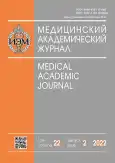Delivery of a DNA vaccine encoding SARS-CoV-2 receptor-binding domain (RBD) by electroporation
- Authors: Kisakov D.N.1, Orlova L.A.1, Sharabrin S.V.1, Rudometov A.P.1, Borgoyakova M.B.1, Starostina E.V.1, Karpenko L.I.1, Ilyichev A.A.1
-
Affiliations:
- State Research Center of Virology and Biotechnology “Vector”
- Issue: Vol 22, No 2 (2022)
- Pages: 191-196
- Section: Conference proceedings
- URL: https://journal-vniispk.ru/MAJ/article/view/108614
- DOI: https://doi.org/10.17816/MAJ108614
- ID: 108614
Cite item
Abstract
BACKGROUND: Nucleic acid-based prevention tools provide a promising platform for developing vaccines, including those against COVID-19. Previously, we developed the pVAXrbd DNA vaccine encoding the receptor-binding domain (RBD) of SARS-CoV-2, which, when administered intramuscularly to animals, induced a relatively weak immune response. The next stage of the study is to increase the immune response, in particular, using electroporation as one of the methods for increasing the immunogenicity of DNA vaccines.
AIM: The aim of this article is to evaluate the immune response using electroporation in mice after immunization with pVAXrbd.
MATERIALS AND METHODS: BALB/c mice were immunized with pVAXrbd using direct and reverse polarity square wave direct current electroporation with three pulses of 12 V for 30 ms and an interval of 950 ml with a current limit of 45 mA.
RESULTS: BALB/c mice were immunized twice with an interval of three weeks with a dose of 100 μg of DNA. Using ELISA, the titers of RBD-specific antibodies in the group of animals immunized with pVAXrbd using electroporation were 1:109350, which is 16 times higher than in the group of animals that received the DNA vaccine only intramuscularly (titers 1:6750). IFNγ ELISpot analysis showed that the largest number of cells (2434 spots/splenocytes, million) producing IFNγ in response to stimulation with peptides from the RBD protein was registered in the group of animals immunized with pVAXrbd using electroporation. For comparison, in the control group, the number of cells is 6.5 times lower: 380 spots / splenocytes, mln.
CONCLUSIONS: Administration of the pVAXrbd DNA vaccine to laboratory animals by electroporation significantly enhances both the humoral and cellular specific immune response compared to intramuscular administration of the naked DNA vaccine.
Keywords
Full Text
##article.viewOnOriginalSite##About the authors
Denis N. Kisakov
State Research Center of Virology and Biotechnology “Vector”
Email: def_2003@mail.ru
ORCID iD: 0000-0003-4889-6865
Junior Research Associate
Russian Federation, Koltsovo, Novosibirsk RegionLyubov A. Orlova
State Research Center of Virology and Biotechnology “Vector”
Email: orlova_la@vector.nsc.ru
ORCID iD: 0000-0001-7214-1855
Trainee Researcher
Russian Federation, Koltsovo, Novosibirsk RegionSergey V. Sharabrin
State Research Center of Virology and Biotechnology “Vector”
Author for correspondence.
Email: sharabrin.sv@gmail.com
ORCID iD: 0000-0003-0664-3587
Scopus Author ID: 57221380569
Junior Research Associate
Russian Federation, Koltsovo, Novosibirsk RegionAndrey P. Rudometov
State Research Center of Virology and Biotechnology “Vector”
Email: rudometov_ap@vector.nsc.ru
ORCID iD: 0000-0003-2808-4309
Cand. Sci. (Biol.), Senior Research Associate
Russian Federation, Koltsovo, Novosibirsk RegionMaria B. Borgoyakova
State Research Center of Virology and Biotechnology “Vector”
Email: borgoyakova_mb@vector.nsc.ru
ORCID iD: 0000-0002-0768-1561
Scopus Author ID: 57221732585
Junior Research Associate
Russian Federation, Koltsovo, Novosibirsk RegionEkaterina V. Starostina
State Research Center of Virology and Biotechnology “Vector”
Email: starostina_ev@vector.nsc.ru
ORCID iD: 0000-0002-1733-9524
Cand. Sci. (Biol.), Research Associate
Russian Federation, Koltsovo, Novosibirsk RegionLarisa I. Karpenko
State Research Center of Virology and Biotechnology “Vector”
Email: karpenko@vector.nsc.ru
ORCID iD: 0000-0003-4365-8809
Scopus Author ID: 7005000410
Dr. Sci. (Biol.), Associate Professor, Leading Research Associate
Russian Federation, Koltsovo, Novosibirsk RegionAlexander A. Ilyichev
State Research Center of Virology and Biotechnology “Vector”
Email: ilyichev@vector.nsc.ru
ORCID iD: 0000-0001-5356-0843
Scopus Author ID: 7006402361
ResearcherId: B-1327-2012
Dr. Sci. (Biol.), Professor, Head of the Department of Bioengineering
Russian Federation, Koltsovo, Novosibirsk RegionReferences
- Chavda VP, Pandya R, Apostolopoulos V. DNA vaccines for SARS-CoV-2: toward third-generation vaccination era. Expert Rev Vaccines. 2021;20(12):1549–1560. doi: 10.1080/14760584.2021.1987223
- Momin T, Kansagra K, Patel H, et al. Safety and immunogenicity of a DNA SARS-CoV-2 vaccine (ZyCoV-D): Results of an open-label, non-randomized phase I part of phase I/II clinical study by intradermal route in healthy subjects in India. EClinicalMedicine. 2021;38:101020. doi: 10.1016/j.eclinm.2021.101020
- Li L, Petrovsky N. Molecular mechanisms for enhanced DNA vaccine immunogenicity. Expert Rev Vaccines. 2016;15(3):313–329. doi: 10.1586/14760584.2016.1124762
- Eusébio D, Neves AR, Costa D, et al. Methods to improve the immunogenicity of plasmid DNA vaccines. Drug Discov Today. 2021;26(11):2575–2592. doi: 10.1016/j.drudis.2021.06.008
- Broderick KE, Humeau LM. Electroporation-enhanced delivery of nucleic acid vaccines. Expert Rev Vaccines. 2015;14(2):195–204. doi: 10.1586/14760584.2015.990890
- Reed SD, Li S. Electroporation advances in large animals. Curr Gene Ther. 2009;9(4):316–326. doi: 10.2174/156652309788921062
- Draghia-Akli R, Khan AS. In vivo electroporation of gene sequences for therapeutic and vaccination applications. Recent Pat DNA Gene Seq. 2007;1(3):207–213. doi: 10.2174/187221507782360245
- Borgoyakova MB, Karpenko LI, Rudometov AP, et al. Immunogenic properties of the DNA construct encoding the receptor-binding domain of the SARS-CoV-2 spike protein. Mol Biol (Mosk). 2021;55(6):889–898. doi: 10.1134/S0026893321050046
- Merkuleva IA, Shcherbakov DN, Borgoyakova MB, et al. Comparative immunogenicity of the recombinant receptor-binding domain of protein S SARS-CoV-2 obtained in prokaryotic and mammalian expression system. Vaccines (Basel). 2022;10(1):96. DOI: 0.3390/vaccines10010096
- Modjarrad K, Roberts CC, Mills KT, et al. Safety and immunogenicity of an anti-Middle East respiratory syndrome coronavirus DNA vaccine: a phase 1, open-label, single-arm, dose-escalation trial. Lancet Infect Dis. 2019;19(9):1013–1022. doi: 10.1016/S1473-3099(19)30266-X
Supplementary files








